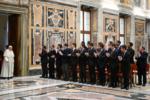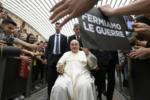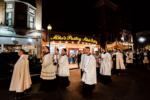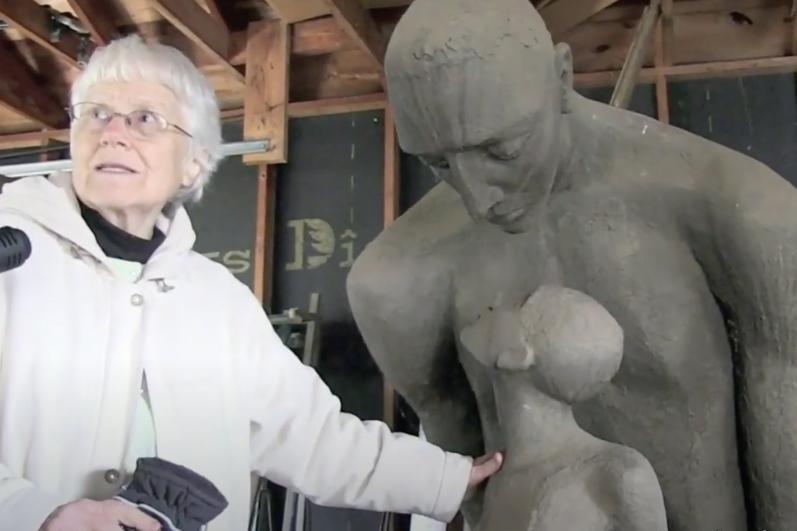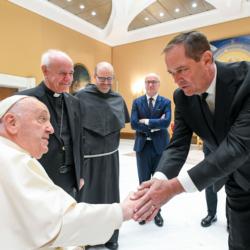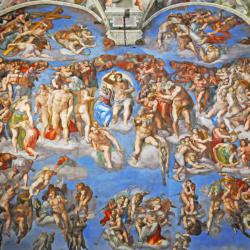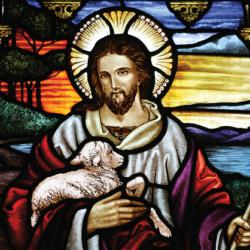Artist interprets 'uncomfortable' story of Abraham and Isaac that's part of Easter Vigil
(OSV News) -- For years, Catholic artist Trina Paulus wrestled with the story of Abraham and Isaac in Genesis 22:1-18.
The story is part of the Easter Vigil, which takes place after sundown on Holy Saturday. Catholics believe it is a foreshadowing of what God is willing to sacrifice for us. As the biblical story goes, in the end, Abraham is stopped by God from that ultimate sacrifice.
"I have done a lot of thinking on this (story) over the years and the great Christian mystery and how it relates to the Crucifixion and Resurrection and that very unpleasant thing that God can ask everything of us," said Paulus, a parishioner of St. Peter Claver Church in Montclair.
It was the "puzzlement" of the story that inspired her to spend a year creating a 6-foot sculpture of the biblical scene. The piece has met with controversy over the years. It depicts Abraham, the father, and Isaac, the son, bound with strips of linen, looking lovingly into each other's faces while Abraham clutches the knife behind his back moments before he will potentially sacrifice his son for God.Paulus said her Abraham and Isaac sculpture illustrates "the strange contradictions between the tender compassion of love and a knife in the other hand."
The piece has traveled quite extensively looking for a home for it to be displayed. For years, it was in storage in Grailville in Ohio, once a lay Catholic community for women who did not have a vocational calling but were deep in faith. Paulus attended in the 1950s and later began the art center there.
"After several places, including a church and bookstore in Hartford, it came back to Columbus, and eventually to Grailville, and now back to be closer to me in New Jersey," in storage at St. Joseph's Shrine in Stirling, Paulus said. "This Abraham also seems to be a wandering Jew!" she told Jersey Catholic, the news website of the Archdiocese of Newark.
Paulus also said she likes to think Abraham and Isaac's case was the last time God ever asked for a human sacrifice.
"It's an incomprehensible story," Paulus said.
"The story preoccupied me as it did Kierkegaard, who wrote a book about different interpretations (of the story)," she said, referring to Søren Kierkegaard's "Fear and Trembling," which gives four different interpretations of Abraham and Isaac.
In Kierkegaard's first version, Abraham decides to kill Isaac in accordance with God's will. Abraham convinces Isaac that he is doing it by his own will, not by God's, because he would rather have Isaac lose faith in his father than lose faith in God.
In the second version, Abraham sacrifices a ram instead of Isaac because God spares him. But Abraham's faith is shaken because God asked him to kill Isaac in the first place.
In the third version, Abraham decides not to kill Isaac and then prays to God to forgive him for having thought of sacrificing his son in the first place.
In the fourth version, Abraham cannot go through with killing Isaac. Isaac begins to question his own faith due to Abraham's refusal to do what God commanded.
The story of Abraham and Isaac also is part of other Christian faiths and the Jewish and Muslim religions, Paulus said. The Muslims celebrate Abraham and Isaac 50 days after Ramadan as a feast parallel to the Crucifixion, Paulus said.
"It's the great mystery feast for them," Paulus said, adding that Muslims have put a lot of emphasis on Isaac's willingness to be sacrificed.
It's a disturbing story to many people of all faiths. Some theologians such as Martin Luther praised Abraham's unquestioning loyalty to God, while others like ethics philosopher Immanuel Kant felt that Abraham should have realized God would never make such an immoral command.
"The Abraham and Isaac event was a foreshadowing of what God himself was going to do, namely, offer his only beloved son, Jesus, as a perfect sacrifice for the sins of the world and thereby prove his love for us," says Catholic365. "In Abraham's case, God did not permit Abraham to complete the task. However, in God's case, he would have to allow the sacrifice of his son to complete, thereby saving the human race."
As Abraham lifts his hand to slaughter Isaac, the angel of the Lord stops him, and God decides to exchange Isaac with a ram of sacrifice. This story is depicted in the paschal mystery -- God's plan of salvation that was ultimately fulfilled through Christ's passion (his suffering and crucifixion), death, resurrection and ascension, according to the website A Catholic Moment.
Jesus is a perfect prefiguration of the ram of sacrifice. God delivered Isaac from death, and in the same way, the world is redeemed through the death of Jesus, an offering of God's own son for the purpose of humankind's salvation.
- - - Jaimie Julia Winters is the editor of Jersey Catholic, the news website of the Archdiocese of Newark.



